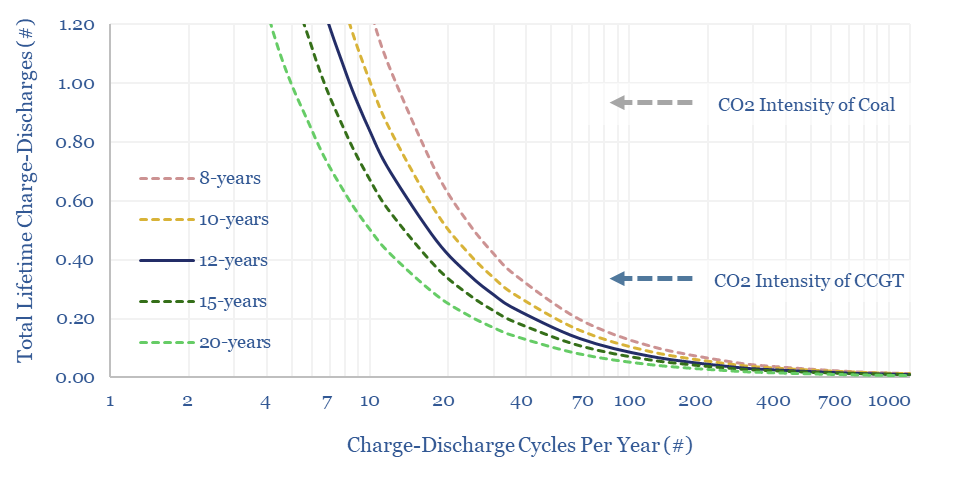The CO2 credentials of long-duration batteries may be as bad as 0.35-2.0 kg/kWh, which is worse than gas peakers, or even than coal power. Grid-scale batteries are best deployed in high-frequency applications, to maximize power quality, downstream of renewables. But we were surprised to find that there is almost no net climate benefit from turning off gas peakers in favor of long-duration, low-utilization batteries.
The Energy and CO2 paybacks of new energies are often called into question. Mostly wrongly, in our view. A solar installation repays its up-front energy and CO2 costs after 1.5-2 years and goes on to have a 10x energy and CO2 payback. A wind installation repays its up-front energy and CO2 costs after 1-year and goes on to have a 20x energy and CO2 payback. It does not help that there are some outdated studies from the mid-2000s still swirling around on the internet.
The Energy and CO2 paybacks of batteries, however, are more nuanced, and depend on how the batteries are used. Our build-up estimates that producing a lithium ion battery requires 175 kWh/kWh of energy and emits 100 kg/kWh of CO2. When this battery is installed in an electric vehicle, achieving 2,250 charge-discharge cycles over the useful life of the battery, then the breakeven comes after 1-year and the total payback is 10x.
For grid-scale batteries, there are many different potential business models. Our favorite is to install grid-scale batteries downstream of renewables projects, to cushion the high short-term volatility of wind, high short-term volatility of solar, provide synthetic inertia, and thus ensure high power quality in increasingly renewable-heavy grids. We see this model playing around already as renewables+batteries co-deployments accelerate. A battery like this can realistically achieve 1-3 charge-discharge cycles per day.
But some renewables advocates have grander ambitions, to use batteries for long-duration storage, in order to push renewables past their natural limits. Renewables will naturally peak at 50-55% of power grids in the best geographies, which can maybe be increased to 60% with demand shifting and some sensible deployments of batteries, which mainly do intra-day load shifting. But pushing renewables beyond this level will incur astronomical costs.
The idea of long-duration storage is to bridge longer periods of low-wind and/or low-solar generation, via batteries that store power for several days, weeks or months, until this energy is needed. This role is currently served by gas peakers, which make up c40% of the gas generation fleet but have utilization rates ranging from 2-20%. Across our research, we see gas plants increasingly being run as peakers, and rising value of peakers, due to increasing grid volatility. This is all due to the economics of gas peakers. Whereas the costs of long-duration, low-utilization batteries are crazy-high, at several hundred cents per kWh.
But the really crazy feature of long-duration energy storage, if it is done via lithium ion batteries, is that the full-cycle CO2 intensity may actually be higher than sticking with gas or even coal. To see this, consider the chart below. A battery that fully charges just 10-times per year, for 10-years, will amortize 100 kg/kWh of battery manufacturing CO2 across 100 total charge-discharge cycles, thus coming out at 1kg/kWh of CO2 intensity. That is dirtier than coal power.

Similarly, a long-duration battery that fully charges and discharges 2x per month, for 12-years, will amortize 100 kg/kWh of up-front battery manufacturing CO2 across 288 charge-discharge cycles over its lifetime, coming out at 0.35 kg/kWh, which is about the same as a typical CCGT power plant today. In other words, there is almost no net climate benefit from turning off the gas peakers in favor of such long-duration, low-utilization batteries.
The chart also confirms that the CO2 credentials are exceptionally good for batteries that get flexed multiple times per day, for a decade or more. Here, the batteries may amortize 100 kg/kWh of up-front manufacturing CO2 across 4,000 – 14,000 charge-discharge cycles, or maybe slightly less if limited by battery degradation, thereby achieving an exceptionally low 0.01-0.03 kg/kWh of total embedded CO2 intensity.
Rapidly cycled batteries are the way to go, for economic costs and CO2 costs, especially where they are co-deployed with renewables in order to ensure high power quality. We cannot see much rationale for replacing gas peakers with long-duration and low-utilizisation batteries. Our own outlook is that gas peakers will retain a long-lasting role in evolving power grids. There are growing opportunities to lower the CO2 footprint of gas power.